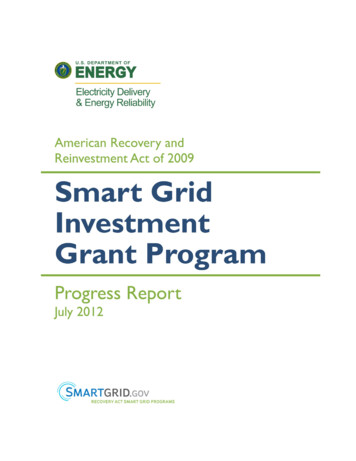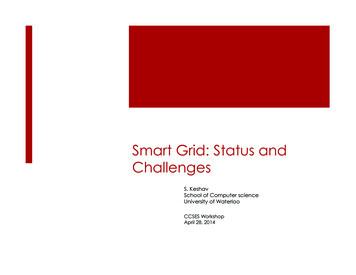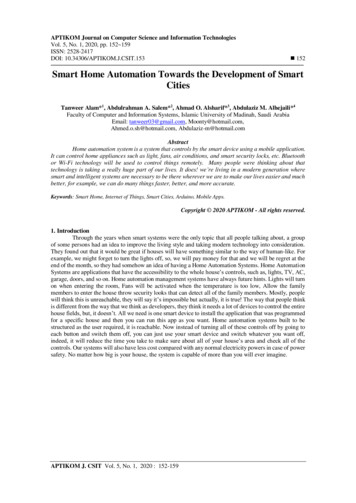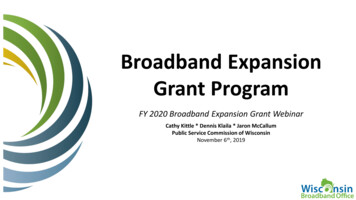
Transcription
U.S. Department of Energy July 2012Table of ContentsExecutive Summary . ii1.Introduction. 11.1The American Reinvestment and Recovery Act of 2009 . 11.2SGIG and Grid Modernization. 21.3Organization of this Report. 32.The SGIG Program . 42.1Program Objectives. 42.2Program Profile . 62.3Analysis and Reporting . 92.4Project Implementation. 93.4.SGIG Implementation Progress . 123.1Schedule of Activities and Expenditures. 123.2Overview of Deployment Progress . 133.3Electric Transmission System Projects. 163.4Electric Distribution System Projects. 213.5Advanced Metering Infrastructure Projects . 243.6Customer Systems Projects . 28Next Steps. 32Appendix A. List of SGIG Projects . A‐1Appendix B. SGIG Project Abstracts. B‐1SGIG Program Progress Report Page i
U.S. Department of Energy July 2012Executive SummaryThe Smart Grid Investment Grant (SGIG) program is a 3.4 billion initiative that seeks toaccelerate the transformation of the nation’s electric grid by deploying smart grid technologiesand systems. The program is authorized in Title XIII of the Energy Independence and SecurityAct of 2007 and is funded by the American Recovery and Reinvestment Act of 2009 (RecoveryAct). The SGIG program and related Recovery Act activities are managed by the U.S.Department of Energy (DOE), Office of Electricity Delivery and Energy Reliability (OE), whichleads national efforts to modernize the nation’s electric grid.It is the policy of the United States to support grid modernization to maintain a reliable andsecure electricity infrastructure.1 The SGIG program implements this policy by makingsubstantial investments in smart technologies and systems that increase the flexibility,reliability, efficiency, and resilience of the nation’s electric grid. Expected benefits include: Reductions in peak and overall electricity demandReductions in operation costsImprovements in asset managementImprovements in outage management and reliabilityImprovements in system efficiencyReductions in environmental emissionsThis report provides a summary of the SGIG program’s progress, initial accomplishments, andnext steps.The Smart Grid Investment Grant ProgramThe SGIG program is structured as a public–private partnership to accelerate investments ingrid modernization. The 3.4 billion in federal Recovery Act funds are matched on a one‐to‐onebasis (at a minimum) with private sector resources—bringing the total investment in SGIGprojects to 7.8 billion. DOE used a merit‐based, competitive process to select and fund 99projects that are now deploying smart grid technologies and systems across the power grid,from transmission system to end‐use customer, in almost every U.S. state.The SGIG program provides a unique opportunity to spur innovation and investment in buildinga smarter electric grid. While the SGIG funds are substantial, recent studies show that hundredsof billions of dollars in smart grid investments will be needed over the next two decades to fully1The Energy Independence and Security Act of 2007, Title XIII Smart Grid, Section 1301.SGIG Program Progress Report Page ii
U.S. Department of Energy July 2012modernize the national electric grid. It will take a sustained commitment by industry,government, states, and other stakeholders to realize this vision.DOE‐OE designed the SGIG program to achieve wide‐reaching, sustainable benefits bysupporting early adopters of smart grid technologies and systems, and collecting performancedata to evaluate and document realized benefits. This approach seeks to reduce uncertaintyand encourage future investors and policy makers to maintain momentum toward amodernized electric grid. The program is designed to: Accelerate electric industry plans to deploy smart grid technologies by several yearsDevelop and transfer know‐how on designing and integrating complex systemsMeasure realized benefits in areas such as asset utilization, system efficiency, reliability,and operations managementAdvance development and deployment of effective cybersecurity protections for smartgrid technologies and systemsImplementation ProgressThe SGIG projects were launched in early 2010, and all projects are expected to completeequipment installation in the 2013–2014 time frame. Data analysis and reporting is expected tobe completed by 2015.As shown in Figure ES‐1, actual spending is on track with planned spending based on estimatesof cumulative project costs submitted by the project recipients. As of March 31, 2012, roughlytwo‐thirds of the total 3.4 billion in federal funds have been expended. Including theinvestments made by the recipients, the combined level of federal and recipient investmenttotals about 4.6 billion, through March 31, 2012.SGIG projects are organized in four areas: Electric Transmission Systems (ETS), ElectricDistribution Systems (EDS), Advanced Metering Infrastructure (AMI), and Customer Systems(CS). Figure ES‐2 shows progress on expenditures in each of these areas. The technologies,systems, and programs in these areas include: ETS – phasor measurement units (PMU), line monitors, and communications networksEDS – automated sensors and controls for switches, capacitors, and transformersAMI – smart meters, communications systems, and meter data management systemsCS – in‐home displays, programmable communicating thermostats, web portals, andtime‐based rate programsSGIG Program Progress Report Page iii
U.S. Department of Energy July 2012Figure ES‐1. Federal SGIG Expenditures versus Plan through March 31, 2012Figure ES‐2. Total SGIG Expenditures by Type of Project through March 31, 2012(combined federal and recipient expenditures)SGIG Program Progress Report Page iv
U.S. Department of Energy July 2012To measure progress of SGIG deployments, DOE‐OE tracks the type and number of technologiesand systems deployed within each project area. For example, the ETS projects track theinstallation of PMUs. These projects have installed more than 287 networked PMUs and a totalof at least 800 networked PMUs will be installed at completion—more than quadruple thenumber of networked PMUs that were installed in the United States before the program. ThesePMUs and associated software applications will help grid operators visualize and respond tovoltage and frequency fluctuations in real time, and improve outage management and systemefficiencies.The AMI projects track the installation of smart meters. These projects have installed more than10.8 million smart meters, which is almost 8 percent of the 144 million meters currently servingelectric customers in the United States.2 At completion, the AMI projects are expected to installa total of at least 15.5 million smart meters, which more than doubles the number of smartmeters that were installed in the United States before the program. In addition, SGIG smartmeter deployments represent a significant contribution toward the 65 million smart metersthat industry estimates will be installed by 2015.3Cybersecurity is a critical element of all SGIG projects. DOE‐OE is working with the SGIG projectrecipients to ensure the SGIG smart grid systems are adequately protected against cyberevents. To date, all recipients have developed cybersecurity plans that are tailored to meet theunique requirements of their project. DOE has reviewed the plans, conducted site visits, andapproved all 99 plans. As the projects are deployed, the plans will be revised to reflect changesin system design and/or the “as built” condition.Selected HighlightsAlthough SGIG projects have focused mainly on deployment, many are already seeing resultsand identifying lessons learned. The examples below illustrate the potential benefits fromselected projects. The Electric Power Board of Chattanooga (EPB) is installing 1,500 automated circuitswitches and sensors on 164 circuits. When nine tornados ripped through communitiesin April of 2011, early in the project’s installation schedule, EPB used 123 of the smartswitches that were in service to re‐route power, avoiding 250 truck rolls and savingcustomers thousands of hours of outage time.2Energy Information Administration, “Electric Power Annual 2010,” November 2011.Edison Foundation, Institute for Electricity Efficiency, “Utility‐Scale Smart Meter Deployments, Plans, &Proposals,” May 2012.3SGIG Program Progress Report Page v
U.S. Department of Energy July 2012 Talquin Electric Cooperative (TEC) in northern Florida has deployed smart meters thathave already produced annual savings of more than 500,000 by avoiding more than13,000 truck rolls for service connections and disconnections and non‐paymentproblems. The system also improves outage management and enables TEC to sendrepair crews to the precise locations where faults have occurred.Oklahoma Gas and Electric (OGE) is implementing time‐based rates and customersystems such as in‐home displays, web portals, and programmable communicatingthermostats to reduce peak demand, defer construction of new power plants, and savemoney on capital expenditures. Based on studies of about 6,000 customers, OGE isrolling out time‐based rates to approximately 150,000 customers over the next severalyears to defer up to 210 megawatts of new power plant capacity.The Western Electricity Coordinating Council (WECC) synchrophasor project involves 18transmission owners in 14 states and is installing 341 PMUs and 62 phasor dataconcentrators (PDC). WECC estimates that the application of these devices will enableapproximately 100 megawatts of additional capacity on the California‐Oregon intertie.Approximately 14 percent of this equipment has been installed to date, and WECC ismoving forward with development of applications, models, and tools for enabling gridoperators to improve power flow management.Next StepsDuring the next 18 months, the SGIG projects will continue deploying technologies and systems,and will provide quarterly reports on installations and costs.As the projects gather more information on their experiences in operating the technologies andsystems, emphasis will shift to the analysis of results, lessons learned, impacts, and benefits.Specifically, DOE‐OE plans to issue a series of five analysis reports in the following areas: Peak demand and electricity consumption reductions from advanced meteringinfrastructure, customer systems, and time‐based rate programsOperational improvements from advanced metering infrastructureReliability improvements from automating distribution systemsEnergy efficiency improvements from advanced Volt/VAR controls in distributionsystemsEfficiency and reliability improvements from applications of synchrophasor technologiesin electric transmission systemsAdditional information, including progress updates and case studies, will continue to be postedon the website www.smartgrid.gov.SGIG Program Progress Report Page vi
U.S. Department of Energy July 20121.IntroductionThis report summarizes the progress made in the Smart Grid Investment Grant (SGIG) programthrough March 31, 2012, including initial program accomplishments and next steps. Most of theaccomplishments focus on the funds expended and assets installed, supported by summaries ofthe initial lessons learned that have been reported.1.1The American Reinvestment and Recovery Act of 2009Congress enacted the American Recovery and Reinvestment Act of 2009 (Recovery Act) tocreate new jobs and save existing ones, stimulate economic activity, and invest in long‐termgrowth. Part of the Recovery Act appropriated 4.5 billion to the U.S. Department of Energy(DOE), Office of Electricity Delivery and Energy Reliability (OE), to jump‐start grid modernizationthrough the deployment of several smart grid programs and related efforts. This funding is oneof the largest federal investments in advanced technologies and systems for the nation’selectric grid. It provides a unique opportunity to spur innovation and investment to enhancethe delivery of electric power through the application of smart grid technologies, tools, andtechniques. Even though the Recovery Act funding for grid modernization is a significantinvestment of taxpayer dollars, experts estimate that hundreds of billions of private capital willbe needed in the years ahead to fully modernize the nation’s entire electric transmission anddistribution grid.4The SGIG program represents the technology deployment portion of the Recovery Act fundsappropriated to DOE‐OE for grid modernization activities. However, sustainable gridmodernization will require more than just the replacement of aging grid assets and thedeployment of advanced technologies. Initiatives are needed to tackle the policy, market, andinstitutional barriers that currently inhibit investments by the private sector.To address these needs, DOE initiated a portfolio of programs (see Table 1) that complementSGIG and will help ensure success by getting markets ready for grid modernization. Oneprogram is developing and training the workers who will be needed to design, build, install, andmaintain smart technologies; another program is developing the interoperability framework—the complex standards that will enable digital components and devices to interoperate securelyand efficiently throughout the electric grid.4Total cost of grid modernization has been estimated at 340– 480 billion, based on the following studies: EPRI, “Estimating the Costs and Benefits of the Smart Grid: A Preliminary Estimate of the InvestmentRequirements and the Resultant Benefits of a Fully Functioning Smart Grid,” Palo Alto, CA, 2011. M.W. Chupka, R. Earle, P. Fox‐Penner, and R. Hledik, “Transforming America’s power industry: The investmentchallenge 2010—2030.” Edison Electric Institute, Washington, D.C., 2008.SGIG Program Progress Report Page 1
U.S. Department of Energy July 2012Major Smart Grid Program ActivitiesTotal Obligations( Million)Smart Grid Investment Grant 3,425Smart Grid Regional and Energy Storage Demonstration Projects 685Workforce Training and Development Program 100Interconnection Transmission Planning 80State Assistance for Recovery Act Related Electricity Policies 49Enhancing State Energy Assurance 44Interoperability Standards and Framework 12Enhancing Local Government Energy Assurance 8Table 1. Federal Recovery Act Funding for Major Smart Grid Program Activities1.2SGIG and Grid ModernizationReliable, affordable, secure, and clean electric power is essential for national security, energysecurity, economic competitiveness, and environmental protection. Yet our nation’s electricinfrastructure is aging, siting of new transmission assets is constrained, and there is a growingneed to integrate more renewable and variable generation resources. As a result, gridmodernization has become a national imperative for meeting the demands of a 21st centuryeconomy.DOE‐OE is responsible for leading national efforts to modernize the electric grid, enhance thesecurity and reliability of the nation’s energy infrastructure, and facilitate recovery fromdisruptions to energy supply. To fulfill these responsibilities, DOE‐OE leads programs inpermitting and siting for grid infrastructure, infrastructure security, and development ofadvanced grid technologies, including smart grid technologies, tools, and techniques. The SGIGprogram is designed to deploy technologies that accelerate the transition to a modern powergrid that integrates the two‐way flow of electricity and information, enables customers tobetter manage their electricity use, and provides more reliable electricity delivery. The impactof SGIG investments will be realized primarily in three ways: Direct investment in smart grid technologies and systems by SGIG projects (e.g., devicesinstalled)Direct benefits realized by SGIG projects through operation of these assets (e.g., costsavings)Reduced uncertainty for decision makers and investors resulting from analysis of thecosts and benefits based on data obtained from SGIG projectsSGIG Program Progress Report Page 2
U.S. Department of Energy July 20121.3Organization of this ReportSection 2 of this report provides a program overview; Section 3 presents implementationprogress within the four project areas: Electric Transmission Systems (ETS), Electric DistributionSystems (EDS), Advanced Metering Infrastructure (AMI), and Customer Systems (CS); andSection 4 outlines next steps. Also included are selected project highlights to illustrate examplesof initial results and lessons learned. Because many of the projects involve more than one ofthe four project areas, the data aggregations in the tables and figures may sum to more than 99projects.Two appendices provide supplemental information about the SGIG program. Appendix A is atable of the 99 SGIG projects and indicates which of the four areas they address. Appendix Bprovides 99 project abstracts and includes information on activities and funding levels.SGIG Program Progress Report Page 3
U.S. Department of Energy July 20122.The SGIG ProgramThe SGIG program is authorized by the Energy Independence and Security Act of 2007, Section1306, as amended by the Recovery Act, which makes grid modernization a national policy. Theprogram’s overall purpose is to accelerate the modernization of the nation’s electrictransmission and distribution systems and promote investments in smart grid technologies,tools, and techniques which increase flexibility, reliability, efficiency, and resilience.2.1Program ObjectivesThe SGIG program is designed to provide a foundation to encourage sustainable investments insmart grid technologies and systems. The program has three main objectives: Accelerate deployment of smart grid technologies across the transmission anddistribution system and empower customers with information so they can bettermanage their electricity consumption and costsMeasure the impacts and benefits of smart grid technologies to reduce uncertainty fordecision makers and attract additional capital and further advance grid modernizationAccelerate the development and deployment of effective cybersecurity protections forsmart grid technologies and systemsThrough these objectives, the SGIG program seeks to achieve the f
Improvementsin asset management Improvementsin outage managementand reliability . actual spending is on track with planned spending based on estimates . The AMI projects track the installation











